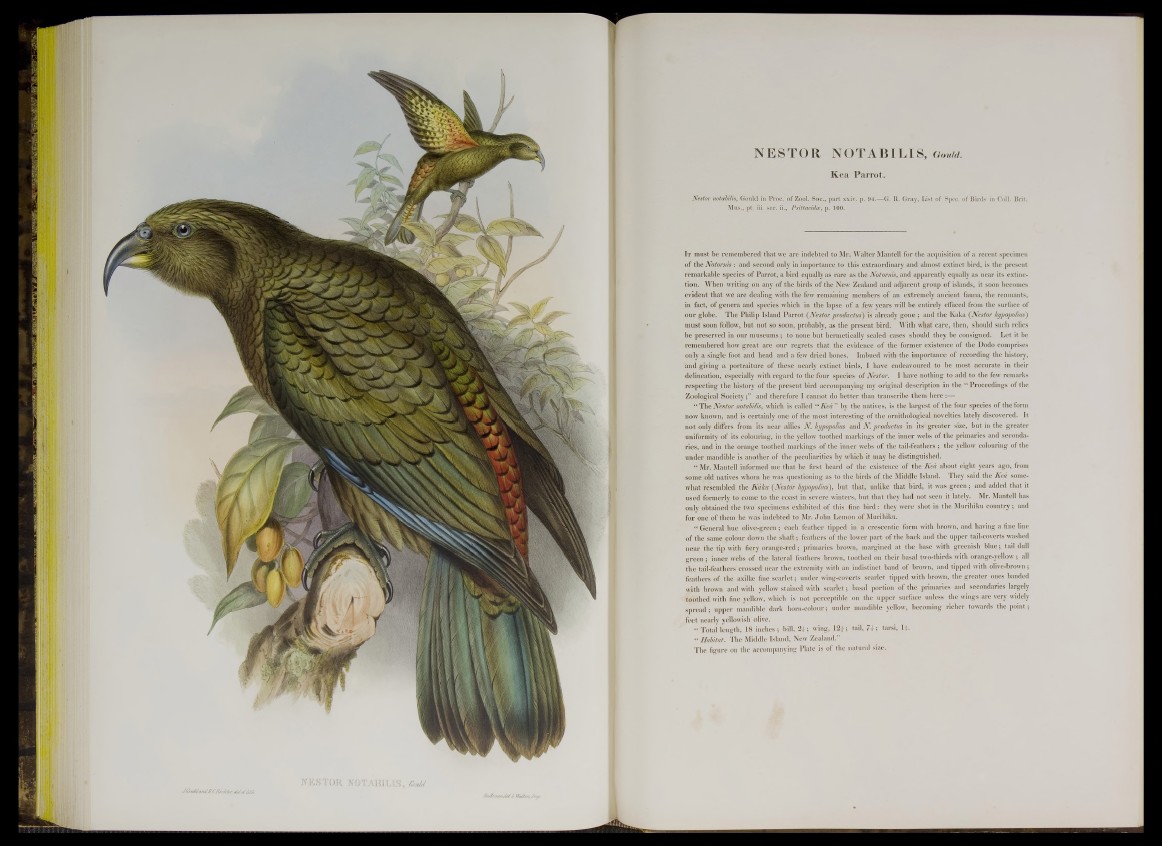
NESTOR NOTABILIS, Goura.
K e a P a rro t.
Nestor notabilis, Gould in Proc. of Zool. Soc., part xxiv. p. 94.—G. R. Gray, List of Spec, of Birds in Coll. Brit.
Mus., pt. iii. sec. ii., Psittacida, p. 100.
It must be remembered that we are indebted to Mr. Walter Mantell for the acquisition of a recent specimen
of the Notornis : and second only in importance to this extraordinary and almost extinct bird, is the present
remarkable species of Parrot, a bird equally as rare as the Notornis, and apparently equally as near its extinction.
When writing on any of the birds of the New Zealand and adjacent group of islands, it soon becomes
evident that we are dealing with the few remaining members of an extremely ancient fauna, the remnants,
in fact, of genera and species which in the lapse of a few years will be entirely effaced from the surface of
our globe. The Philip Island Parrot (Nestor productus) is already gone ; and the Kaka (Nestor hypopolius)
must soon follow, but not so soon, probably, as the present bird. With what care, then, should such relics
be preserved in our museums; to none but hermetically sealed cases should they be consigned. Let it be
remembered how great are our regrets that the evidence of the former existence of the Dodo comprises
only a single foot and head and a few dried bones. Imbued with the importance of recording the history,
aud giving a portraiture of these nearly extinct birds, I have endeavoured to be most accurate in their
delineation, especially with regard to the four species of Nestor. I have nothing to add to the few remarks
respecting the history of the present bird accompanying my original description in the “ Proceedings of the
Zoological S o c i e t y a n d therefore I cannot do better than transcribe them h ere:—
“ The Nestor notabilis, which is called “K e a ” by the natives, is the largest of the four species of the form
now known, and is certainly one of the most interesting of the ornithological novelties lately discovered. It
not only differs from its near allies N. hypopolius and N. productus in its greater size, but in the greater
uniformity of its colouring, in the yellow toothed markings of the inner webs of the primaries and secondaries,
and in the orange toothed markings of the inner webs of the tail-feathers ; the yellow colouring of the
under mandible is another of the peculiarities by which it may be distinguished.
“ Mr. Mantell informed me that he first heard of the existence of the Kea about eight years ago, from
some old natives whom he was questioning as to the birds of the Middle Island. They said the Kea somewhat
resembled the Kaka (Nestor hypopolius'), but that, unlike that bird, it was g re en; and added that it
used formerly to come to the coast in severe winters, but that they had not seen it lately. Mr. Mantell has
only obtained the two specimens exhibited of this fine b ird : they were shot in the Murihiku country; and
for one of them he was indebted to Mr. John Lemon of Murihiku.
“ General hue olive-green; each feather tipped in a crescentic form with brown, and having a fine line
of the same colour down the shaft; feathers of the lower part of the back and the upper tail-coverts washed
near the tip with fiery orange-red; primaries brown, margined at the base with greenish blue; tail dull
green ; inner webs of the lateral feathers brown, toothed on their basal two-thirds with orange-yellow ; all
the tail-feathers crossed near the extremity with an indistinct band of brown, and tipped with olive-brown;
feathers of the axillse fine scarlet; uuder wing-coverts scarlet tipped with brown, the greater ones banded
with brown and with yellow stained with scarlet; basal portion of the primaries and secondaries largely
toothed with fine yellow, which is not perceptible on the upper surface unless the wings are very widely
spre ad; upper mandible dark horn-colour; under mandible yellow, becoming richer towards the p o in t;
feet nearly yellowish olive.
“ Totai length, 18 inches ; bill, 2*; wing, 12*; tail, 7*; tarsi, 1*.
“ Habitat. The Middle Island, New Zealand.”
The figure on the accompanying Plate is of the natural size.